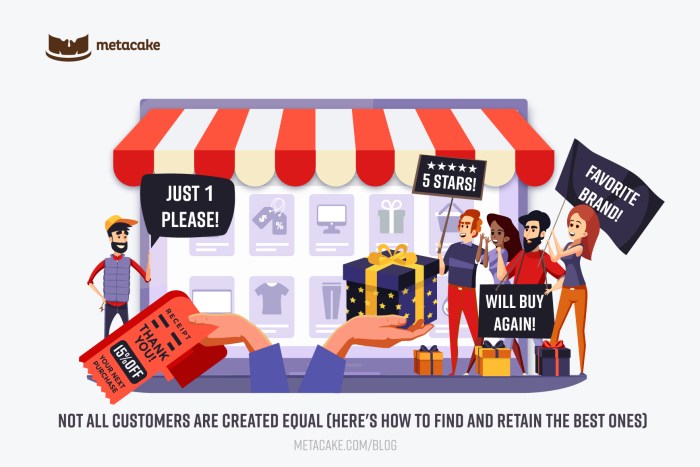Not all customers are created equal. This fundamental principle underpins the practice of customer segmentation, which recognizes that different customer groups possess distinct needs, preferences, and behaviors. Understanding and leveraging this heterogeneity is crucial for businesses seeking to optimize their marketing, sales, and customer relationship management efforts.
By tailoring strategies to specific customer segments, businesses can enhance their marketing effectiveness, foster stronger relationships with high-value customers, and drive product innovation that meets unmet needs. However, ethical considerations must be carefully navigated to ensure transparency and fairness in customer segmentation practices.
Understanding the Meaning of the Phrase

The phrase “not all customers are created equal” acknowledges the inherent heterogeneity of customer populations. Customer segmentation is the process of dividing customers into distinct groups based on shared characteristics, such as demographics, behavior, or needs. These differences in customer profiles lead to diverse requirements, preferences, and responses to marketing efforts.
Factors contributing to customer heterogeneity include:
- Demographics: Age, gender, income, education, location
- Behavior: Purchase history, frequency of visits, channel preferences
- Needs: Specific product or service requirements, value propositions
- Psychographics: Personality traits, lifestyle, attitudes
Recognizing these differences enables businesses to tailor their marketing strategies to resonate with the unique needs of each customer segment.
Implications for Marketing and Sales
Understanding customer heterogeneity is crucial for effective marketing and sales strategies. By segmenting customers, businesses can:
- Target marketing messages to specific segments with relevant content and offers
- Personalize customer experiences based on their unique preferences
- Develop tailored marketing campaigns that resonate with the needs of each segment
- Optimize pricing and promotional strategies for different customer groups
Successful marketing campaigns that leveraged customer segmentation include:
- Nike’s “Find Your Greatness” campaign, which targeted different customer segments with tailored messaging and experiences
- Amazon’s personalized product recommendations, which leverage customer purchase history and preferences
Managing Customer Relationships

Customer heterogeneity has a significant impact on customer relationship management (CRM). Different customer segments require different approaches to relationship management:
- High-value customers: Prioritize personalized service, exclusive offers, and relationship-building initiatives
- Loyal customers: Foster loyalty through rewards programs, personalized experiences, and exceptional customer support
- At-risk customers: Identify and address concerns proactively to prevent churn
- New customers: Focus on onboarding, building trust, and establishing a positive relationship
Building and maintaining strong relationships with high-value customers is crucial for business growth. Strategies include:
- Providing exceptional customer service and support
- Offering personalized rewards and loyalty programs
- Tailoring marketing messages to their specific needs
Pricing Strategies

Customer heterogeneity influences pricing decisions. Different customer segments may have varying price sensitivities and willingness to pay:
- Value-based pricing: Setting prices based on the perceived value of the product or service to different customer segments
- Tiered pricing: Offering different pricing options based on features, benefits, or usage levels
- Dynamic pricing: Adjusting prices based on demand, competition, or customer characteristics
Case studies of companies that successfully implemented differentiated pricing strategies include:
- Amazon’s tiered pricing for Prime members
- Uber’s surge pricing during peak demand
Product Development and Innovation: Not All Customers Are Created Equal.
Understanding customer heterogeneity can drive product development and innovation:
- Market research: Identifying unmet customer needs and preferences through surveys, focus groups, and data analysis
- Niche markets: Targeting specific customer segments with specialized products or services
- Personalized products: Customizing products or services to meet the unique needs of individual customers
Examples of products or services designed specifically for niche customer segments include:
- Apple’s iPhone Pro, targeted at professional photographers and videographers
- Tesla’s electric vehicles, designed for environmentally conscious consumers
Ethical Considerations
Treating customers differently based on their characteristics raises ethical concerns:
- Transparency: Customers should be aware of how their data is being used for segmentation and personalization
- Fairness: Segmentation practices should not discriminate against or unfairly target specific customer groups
- Privacy: Customer data should be collected and used ethically and in accordance with privacy regulations
Companies that have faced criticism for their customer segmentation strategies include:
- Facebook, for using customer data to target political advertising
- Amazon, for allegedly using customer data to gain an unfair advantage over competitors
Detailed FAQs
What are the key factors that contribute to customer heterogeneity?
Customer heterogeneity is influenced by a multitude of factors, including demographics, psychographics, behavioral patterns, and purchase history.
How can businesses effectively manage relationships with different customer segments?
Effective customer relationship management involves tailoring communication, service levels, and loyalty programs to the unique needs and expectations of each segment.
What are the ethical implications of treating customers differently based on their characteristics?
Businesses must ensure transparency and fairness in their customer segmentation practices, avoiding discrimination or unfair treatment based on protected characteristics.